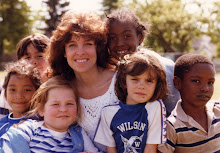THREE THEORIES OF LITERACY INSTRUCTION
The point of using the three texts included below is that they represent three common theories about how people learn to read. All teachers operate from a theory (whether they're conscious of it or not) and the experience of these three models in action offers them a chance to become more aware and reflective about their teaching.
THE PHONICS MODEL
Reading programs are based on particular assumptions. A phonics model is based on the belief, for instance that kids first learn individual sounds, and as they have mastered 5-6 sounds, small words can be composed of those, making reading to learn "easy." This is a commonsensical idea, hence the proliferation of BOB books and other phonetically controlled readers.
The story used to illustrate the phonics model is called a A Pin for Dan. We used flashcards and word
 lists that the group read prior to reading the story, and the text contained no pictures. Those espousing this model often believe that seeing pictures allows kids to figure out the words and is "cheating." The list of words reads: pin, win, bin, tin, in, into. Can you figure out the second column? Even I have to work hard to remember that the only change is an /S/ added to the end of each word. The sight word is circled: of.
lists that the group read prior to reading the story, and the text contained no pictures. Those espousing this model often believe that seeing pictures allows kids to figure out the words and is "cheating." The list of words reads: pin, win, bin, tin, in, into. Can you figure out the second column? Even I have to work hard to remember that the only change is an /S/ added to the end of each word. The sight word is circled: of.The story, again without illustrations so readers won't cheat by looking at them, is below. See how well you can read it.

The reality is that for many young readers, books that don't sound like real language make learning to read much more difficult.
THE SKILLS MODEL
THE SKILLS MODEL
First students are grouped by their "ability" to read in this way. Vocabulary and skills are taught to each group, next comes the story, and then the kids complete worksheets to apply their new learning. Games are often included as independent work: flashcards, word searches, and coloring sheets.
The story used to illustrate the skills model is It Will Not Go. We worked on the intro skills page together (introducing the pronouns: I, we, it), then used flashcards on beginning and ending sounds, then read the coded story. Students then return to their seats to independently complete three worksheets. This group of readers was allowed to "go out to recess" when they finished the worksheets. I used this same structure for the adults in our class.



THE HOLISTIC MODEL
The third, holistic model, assumes that the smallest "unit of meaning" is an entire text, rather than individual letters and sounds or words. A familiar text (or with a pattern readers can pick up) and real language makes the early reading experience easier rather than harder, even though the story is much longer. The lesson is organized so readers work together (the earlier models are characterized by working alone: "keep your eyes on your own paper," playing "around the world" with the flashcards so the quick kids earn cards and the more deliberative or thoughtful kids are "less successful", etc).
The text used to illustrate the holistic model was The Three Little Pigs. This group did a "picture walk" through the story in pairs, the whole group talked about their predictions, and then we read the story together as a group. Everyone knows the story and some of the lines, so there is a lot of predictability. People can use what they know to figure out what they don't know. The illustrations are an integral feature of the reading experience.



Both of the phonics and skills models are based on the assumption that there is a clear sequence to how kids learn language. The researchers I studied with clearly showed that there is no specific sequence, but rather that different kids attend to different features of language in their environment. The role of the teacher is to closely observe kids immersed in using language (big books, read aloud, talking, early writing, etc.), see what they know and are able to do, and to provide demonstrations that will help them do it better. A language rich environment is key. (More on that in a future posting.)
The analogy to the early reading experience for kids only goes so far, as adult students can use what they know about written English to decode these coded texts. Further, these adults weren't required to write in each model, as kids would be. Spelling tests, copying from the board, and homework assignments are also treated differently among these models. By the way, Houghton Mifflin published a similar engagement in the '70s called A Primer for Parents. Interested readers might be able to track it down.
In our course, this reading experience set up months of professional reading and study on how reading is taught. Here is one post that illustrates my beliefs about how to support early reading.




No comments:
Post a Comment